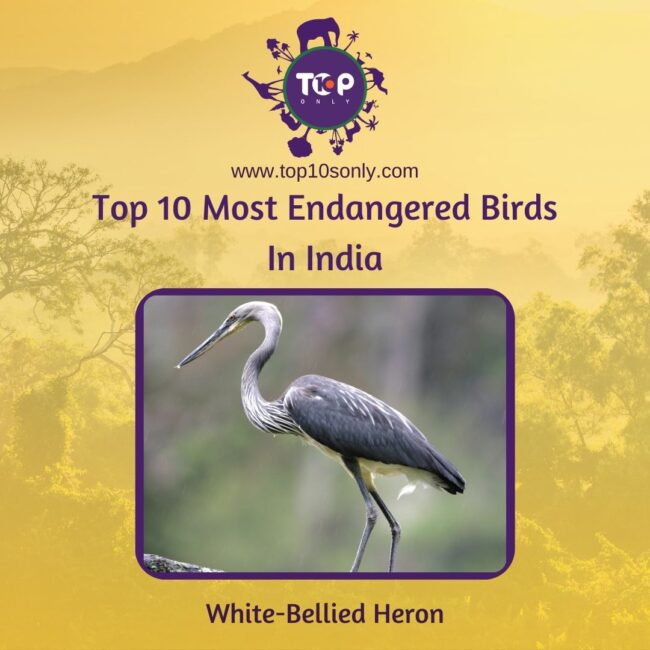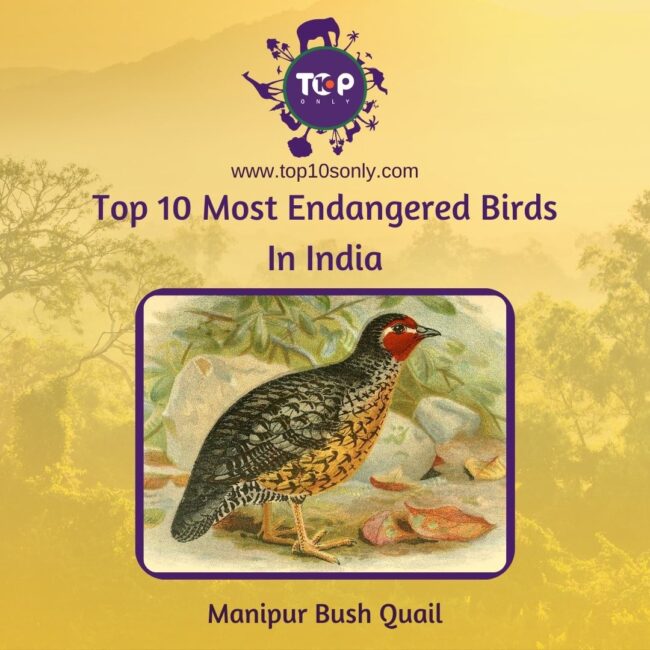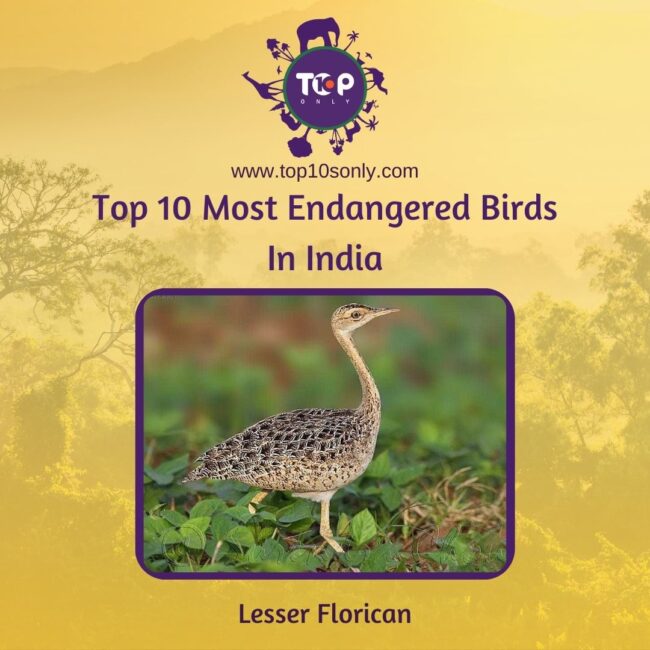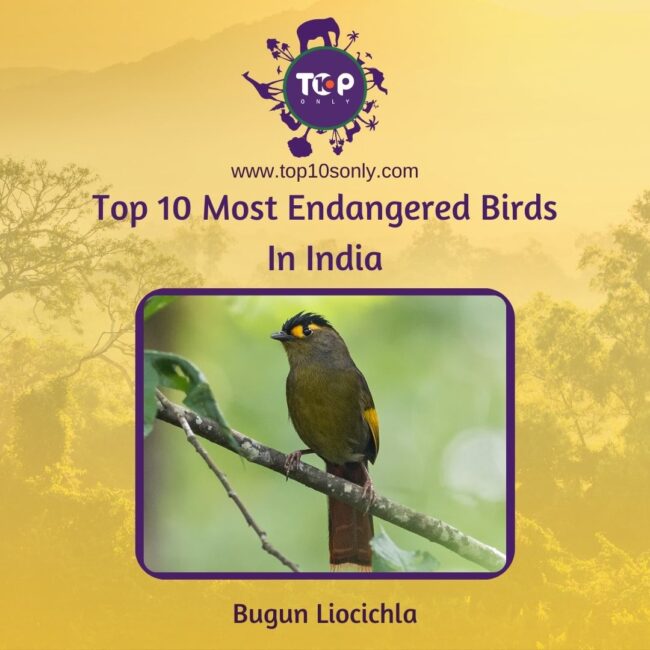
India is beautiful with its rich landscape and biosphere. This land, celebrated in our national song Vande Mataram as “Sasyashyamalam Mataram,” is blessed with lush greenery and abundant natural resources. However, over time, urbanisation and modern ways of life have led to the destruction of nature, resulting in the loss of habitat for many birds and animals. Protecting endangered species became crucial to preserving ecological balance. Among these, many birds face the risk of extinction due to many factors.
If you want a more detailed look at some of these endangered birds go through this blog by Top 10s Only! Here, you can learn about the Top 10 Most Rare And Endangered Birds In India and the threats they face.
Learn More About Ten Of India’s Most Rare And Endangered Birds
Human activities have severely impacted the lives of many animals and birds. Climate change and habitat loss have led to the addition of many birds to the list of birds endangered in India. Raising awareness about endangered birds is crucial, as it may help people to understand why birds are endangered and encourage them to adopt more responsible behaviours that help protect wildlife. So, let’s take a quick look at the top 10 endangered birds with names and pictures listed below:
1. Great Indian Bustard

Great Indian Bustard
The Great Indian Bustard was once commonly seen in the central, peninsular, and western parts of India. Grasslands with dry scrubs or short grasses are its habitat. This bird is the state bird of Rajasthan and was once considered a potential candidate for India’s national bird. It is the heaviest flying bird, and it is 3 feet high. These are omnivores and feed on arthropods, worms, small reptiles, and mammals.
Due to heavy hunting and habitat loss, the Great Indian Bustard is fast disappearing from many parts of the country. It has become one of the most endangered birds in India. Efforts are being made to protect this species, and the Great Indian Bustard Sanctuary in Solapur, Maharashtra, serves as a dedicated wildlife sanctuary for its conservation. This bird, locally known as Godavan, is protected in the Desert National Park, Rajasthan.
2. Indian Vulture

Indian Vulture
Belonging to one of the most critically endangered bird species in India, the Indian vulture, scientifically known as Gyps Indicus, is commonly found in central and peninsular India. It is often seen near human-dwelling places. Its unique characteristics include pale eye rings, a sturdy black neck, a light yellow bill, a dark torso, and white feathers. These scavenging birds feed on animal carcasses. They are usually seen in groups and soar high in the sky to look for their food.
Unfortunately, this bird is in the endangered category because there has been a sudden decline in their population since 1990. The reason is that the use of anti-inflammatory drugs like diclofenac in cattle causes harmful effects on this species. There are Indian vulture breeding centres like Pinjore Vulture Breeding Centre in Haryana and Rajabhatkhawa Vulture Conservation Breeding Centre in West Bengal that raise vultures in order to conserve these birds, which play a vital role in keeping ecological balance.
3. White-Bellied Heron

White-Bellied Heron
The next bird on our endangered species of India list is the White-Bellied Heron. These birds are large in size and are found near the watersides of the mountainous forest areas. They were mostly present in the Himalayan region. These large, elegant birds are stone-grey in colour with pale patches, a white belly and dark grey wings.
Over time, these birds became very rare due to the loss of their habitat or degradation of their dwelling places due to mining, the removal of soil from river beds, converting wetlands to agricultural areas, etc. Rigorous efforts are being put into protecting this critically endangered species, such as minimising human impacts on water bodies as well as wetlands. For instance, the Namdapha Tiger Reserve is one such initiative to protect the White-bellied Heron population, keeping them out of disturbances due to human activities.
4. Forest Owlet

Forest Owlet
The forest owlet is another bird that is extremely rare, with its count dropping below 1000 in India. These birds are typically found around the central part of India. They have a wider skull and a larger beak. Grey-brown feathers, white underparts, yellow eyes, and a dark brown head with white spots are notable features of these small birds.
Drastic destruction of their natural habitat, the dry tropical deciduous forests, have endangered these Strigidae species. Measures are being taken to prevent the illegal felling of trees in the forests and preserve teak wood plantations and grasslands home to small rodents that are its prey. These measures, along with educating people, may help protect these small and rare birds.
5. Red-Headed Vulture

Red-Headed Vulture
Red-headed vultures are old-world vultures mainly found in the northern part of India. These are usually medium-sized birds that weigh around 3-6 kg. They have a black body, pale grey-tipped feathers, and a deep red or orange-coloured head. Their natural habitat includes open country, foothills, river valleys, or wetlands. They nest on the top of tall trees.
These majestic-looking birds, also known as Pondichery vultures, Indian black vultures or Asian king vultures, are now becoming rare, with their population going below 10,000. These scavenger birds, which rely on animal carcasses for food, are facing endangerment due to habitat destruction and contaminated food sources, usually because of the diclofenac used in livestock treatment.
6. Slender-Billed Vulture

Slender-Billed Vulture
Slender-billed vultures are another group of old vulture species close to becoming extinct. This species’ unique characteristics include a slim body, longer bill, longer legs, large eyes, a short tail, and large wings. It belongs to the Gyps species (Gyps Tenuirostris), one of the most critically endangered species in India. Slender-billed vultures have a dark neck and head. Like other vultures, these endangered birds feed on carcasses, which, in turn, help clean up the environment.
In the early 1990’s, these were very common vulture groups that used to be found in human-populated areas, especially near slaughterhouses. The increased use of painkiller drugs in veterinary medicine and the reduction of wetlands and woodlands affected the vulture species’ population. Conscious efforts to conserve these birds are in place, like captive breeding and SAVE (Saving Asia’s Vultures from Extinction) to enhance the vulture population, as well as create vulture-safe areas.
7. Manipur Bush Quail

Manipur Bush Quail
The Manipur bush quail, or Perdicula Manipurensis, is a quail species found in the northeastern parts of India. These small birds are dark greyish in colour, with a yellowish brown belly, blackish markings, and a reddish or grey face. They feed on seeds of herbs and grasses as well as small insects. These birds live only in very specific areas, like dense grasslands filled with elephant grass, scrub forests, or swamps.
Due to habitat loss, their population has fallen to below 2500 and has thus become one of the most threatened birds of India. They are now found in the Assam Plains Endemic Bird Area. Efforts are in place to restore their natural habitat, prevent hunting, and protect them from falling prey to other animals in a higher order of the food chain.
8. Lesser Florican

Lesser Florican
Bustards are a species of birds found in dry grasslands and steppe regions. The Lesser Florican, scientifically known as Sypheotides Indicus, is the smallest bird in the bustard family. These birds, locally known as Karmore or Likh, are found in a few Indian states like southeastern Rajasthan, Gujarat, Western Madhya Pradesh, and northwestern Maharashtra. These local migrant birds are black with pale wings or light brown in colour.
Habitat loss or conversion of grasslands affected the survival of these birds. The Endangered Species Recovery Program of the Wildlife Institute of India and the Bombay National History Society are jointly planning ways to conserve these endangered birds.
9. Jerdon’s Courser

Jerdon’s Courser
Jerdon’s courser is a short and delicate bird endemic to the Eastern Ghats of Andhra Pradesh. These cute birds, which have the scientific name Rhinoptilus Bitorquatus, derived their common name after Thomas C. Jerdon, who discovered them. These small birds are unique because of their bicoloured bill, white eyebrows, brown breasts with two white bands, and large eyes. These nocturnal birds are largely found in patches of scrub forests.
These birds were believed to be extinct but were rediscovered in 1986. They can now be found in Sri Lankamalleswara Wildlife Sanctuary and Sri Penusila Narasimha Wildlife Sanctuary. The Jerdon’s Courser Recovery Programme aims to restore these birds’ lost habitat by removing non-native tree species and monitoring the birds and their habitat.
10. Bugun Liocichla

Bugun Liocichla
India’s most critically endangered bird, the Bugun Liocichla, with the scientific name Liocichla bugunorum, is a new type of bird found in 1995. These are found in Arunachal Pradesh, and their dwelling places are the hillsides with small trees and shrubs. These birds belong to the passerine bird species. These birds have olive-grey plumage, orange-yellow lore in their faces, multicoloured patched wings (yellow, red, white) and a black cap. Their blacktail with crimson-coloured undertail, black bill, and pink feet make these birds attractive.
Bugun Liocichla are considered endangered because they are not common and have a small population. Hence, plans are made to protect these birds’ primary habitat, even if they are capable of surviving in degraded forests.
Learn About Endangered Indian Bird Species To Conserve Them For Future Generations
Ecological balance can be maintained only if all the species of birds and animals are protected. Various human activities have destroyed the dwelling places of various birds and animals. This blog highlights the birds that are on the verge of extinction in India and promotes the importance of conserving such globally threatened bird species. The International Union for Conservation of Nature (IUCN) is working on conserving nature, and the younger generation needs to join hands with the IUCN’s efforts for our survival.
Frequently Asked Questions
1. What are the 10 endangered birds in India?
- Great Indian Bustard
- Forest Owlet
- Manipur Bush Quail
- Bugun Liocichla
- Jerdon’s Courser
- Red-Headed Vulture
- Slender-Billed Vulture
- Indian Vulture
- Lesser Florican
- White-Bellied Heron
These are the top 10 most rare and endangered birds in India.
2. Which national bird is endangered in India?
The Great Indian bustard, the state bird of Rajasthan, was one of the bird species considered while choosing the national bird of India. Today, its population has been severely reduced, and it is on the IUCN (International Union for Conservation of Nature) list of critically endangered birds in India.
3. What is the rarest bird in India?
The Manipur Bush Quail and Bugun Liocichla are thought to be critically endangered as their sightings have become quite rare.
